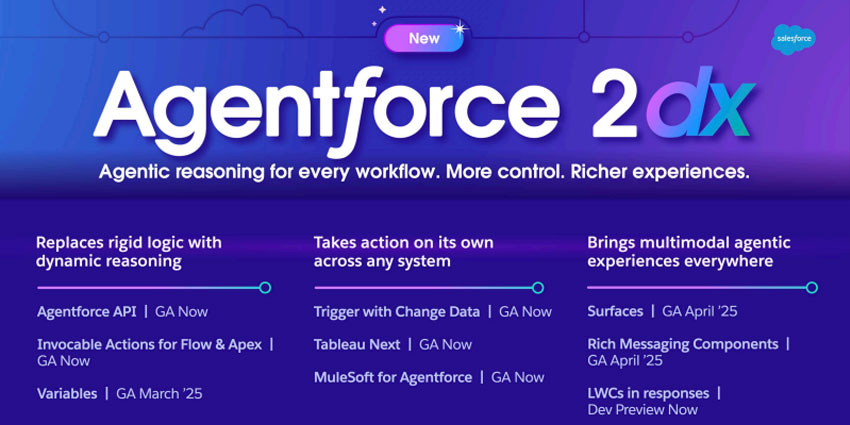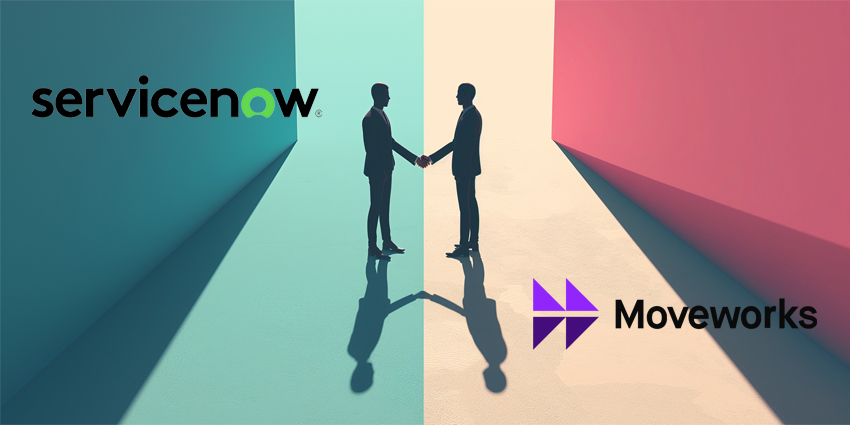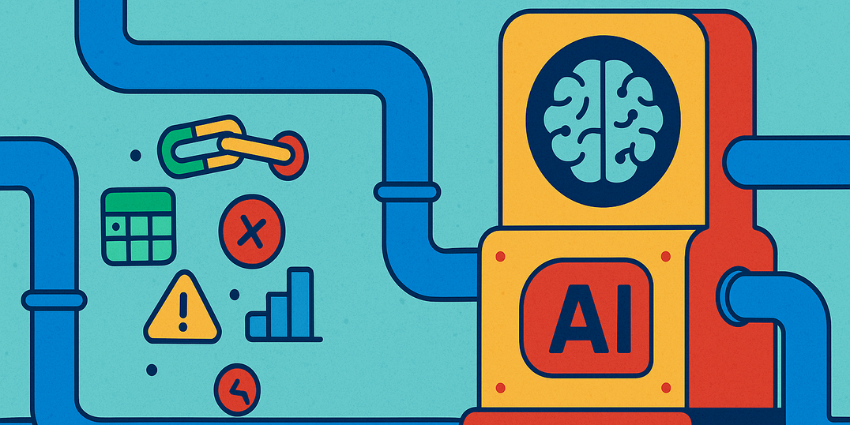Salesforce has launched the next generation of Agentforce: Agentforce 2dx.
Following the December announcement of Agentforce 2.0, Salesforce’s AI agents now go beyond its CRM ecosystem, automating processes across departments and systems.
That’s a significant step for Salesforce. No longer is it talking just about the front office; it’s also taking its AI agents into the back office.
Agentforce 2dx will support developers with a new set of low-/no-code tools to configure, test, and deploy AI agents that span the enterprise.
Yet, the release offers much more than new developer tools. It also helps shine a light on the direction of Salesforce as it advances its agentic AI platform.
Given that, here are five major talking points from the release.
1. Salesforce Enables More Proactive AI Agents
“Agentforce APIs” and new MuleSoft APIs are a critical part of the 2dx release. These enable the integration of Agentforce into back-end processes and applications.
Alongside this are new Invocable Actions that automate actions based on business events.
While such developments are significant in taking Agentforce beyond the Salesforce ecosystem, Adam Evans, EVP & GM of Salesforce AI, also highlights how they support new, proactive AI agent use cases.
“Agents can be triggered from any platform event,” he said. “So, any time a record is changed, a new case comes in… anything inside the Salesforce unified platform can begin an agent to do work in the background.
“This change is significant, as… Agentforce now has the ability to be proactive.”
Consider an example of a proactive Agentforce agent in telecommunications. It could monitor network outages and – when one occurs – proactively warn affected customers.
Yet, this is just one of many possible examples spanning the enterprise.
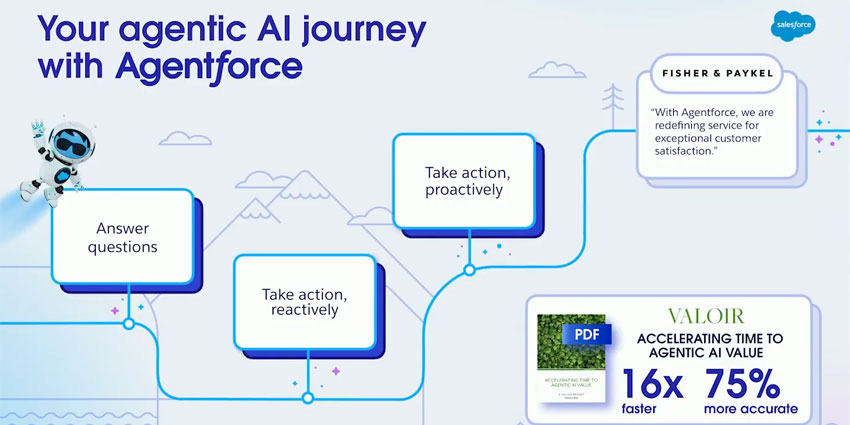
2. Agentforce 2dx Self-Diagnoses Data Gaps
If an agent fails to complete a task accurately, Agentforce may pinpoint whether the issue is due to missing data or unclear instructions.
Such reverse engineering – enabled by Salesforce Atlas – allows brands to optimize AI agent performance.
With a new Agentforce Interaction Explorer module, 2dx builds on this further.
Referencing this, Evans noted:
With advanced analytics, we’re now getting real-time insights into agent performance and recommendations about how to improve them as we move forward. This gives CIOs and IT leaders more confidence than ever to measure the ROI of their AI.
3. Slack Becomes the Center Point for a Human-AI Hybrid Workforce
Last month, Salesforce introduced Agentforce for Slack, presenting the platform as a hub for a hybrid human and AI workforce.
Now, Salesforce has added an “Agentforce Steps in Slack Workflow Builder” tool that allows developers to trigger automations in other systems based on Slack events.
There’s also Agentforce Employee Templates for employees to kickstart automated workflows – which cross various enterprise systems – in Slack.
These moves are significant. After all, as AI agents get more sophisticated, businesses will need an operational center point to monitor performance and receive alerts when something goes wrong.
That’s where Slack comes in. It has become a new conversational interface for work.
4. Salesforce Tackles Security and Governance Concerns
2dx also introduces new integrated security and governance features from Salesforce’s 2024 Own Company pickup.
After all, many organizations have struggled to get AI across the finish line because of concerns about what the AI might do with their data, how it might access it, and, importantly, what it could potentially leak.
Without these safeguards, AI adoption has been limited to proof-of-concept stages – often driven by a fear of missing out or pressure from boards – rather than full-scale production and use.
Salesforce’s integration of Own Company and all its assets, security features, and identity management capabilities brings a much-needed focus on security and governance.
5. From AppExchange to AgentExchange
Alongside 2dx, Salesforce announced AgentExchange, a marketplace and community built into its Agentforce platform.
By fostering collaboration among partners, developers, and “Agentblazers,” AgentExchange will see the CRM leader’s community share prototype AI agents for others to leverage.
The launch includes over 200 partners and a wealth of pre-built actions, templates, and topics that adhere to “rigorous” security and quality standards.
With AgentExhange, Salesforce hopes to improve time to value and inspire innovation.
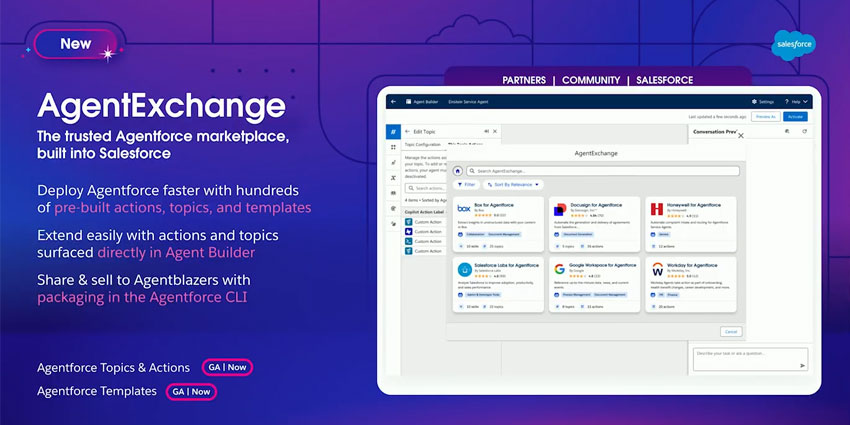
More on Agentforce 2dx
Alongside the features above, 2dx offers a free environment to access Agentforce and Data Cloud, enabling businesses to start prototyping their first use cases.
Then, there is a new “AI assistance in Agent Builder” capability, supporting the faster production of AI agents with AI-generated instruction guidance.
Salesforce has also built out its Agentforce Testing Center. As well as providing a sandbox to generate and run test cases, this allows developers to isolate how well agents adhere to guardrails like faithfulness or context relevance.
By building out these features, Salesforce hopes to build further momentum around its agentic AI platform, with 5,000+ organizations now leveraging Agentforce.
